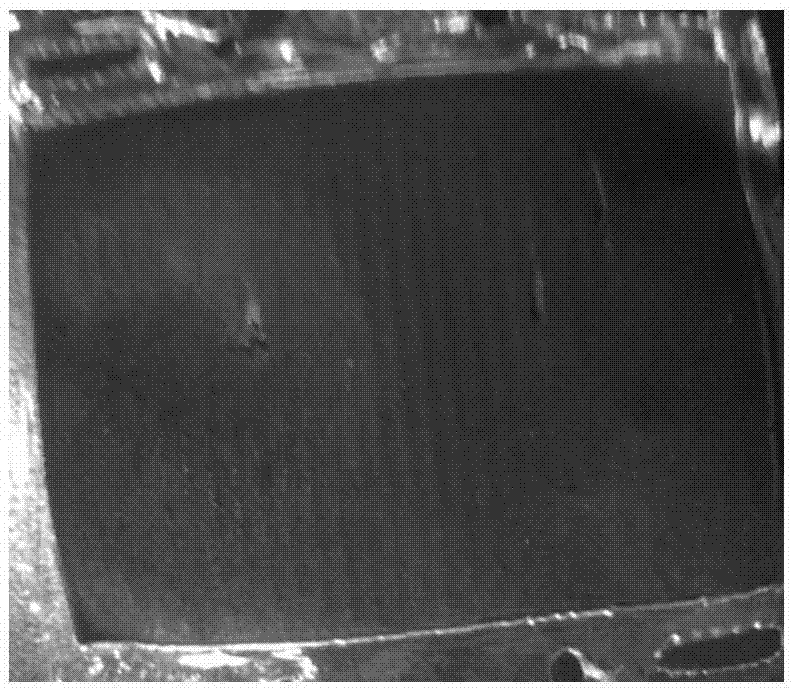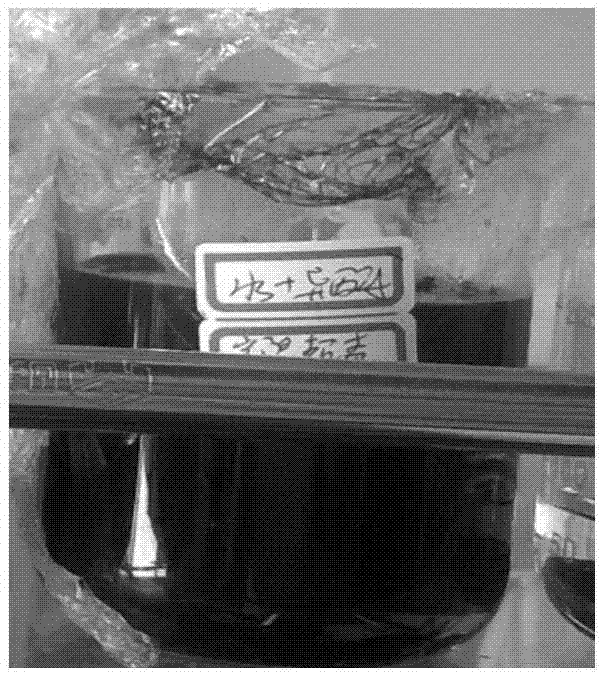Method for recycling membrane electrode of proton exchange membrane fuel cell
A technology of proton exchange membrane and fuel cell membrane, which is applied in the field of fuel cells, can solve problems such as cost reduction and disadvantages, and achieve the effect of cost reduction
- Summary
- Abstract
- Description
- Claims
- Application Information
AI Technical Summary
Problems solved by technology
Method used
Image
Examples
Embodiment 1
[0030] will be 50cm 2 The direct methanol fuel cell CCM( figure 1 The total amount of cathode and anode catalysts is 9 mg cm -2 ), placed in a 250mL beaker, and added an aqueous alcohol solution prepared with a ratio of isopropanol and water of 1:1, and the solution covered the CCM. Place the beaker in an ultrasonic wave for 30 minutes, take out the residual flakes and rinse them with an alcohol solution with a ratio of 1:1 between isopropanol and water, and then treat them in 6wt% hydrogen peroxide, 0.5mol / L sulfuric acid and deionized water at 80°C Each treatment was performed in 60 minutes to obtain a complete Nafion membrane ( figure 2 ). The electrical conductivity of the Nafion film obtained was 89mS / cm, the elongation at break was 388%, the tensile strength was 12.4MPa, and the Young's modulus was 132MPa. The black slurry in the beaker ( image 3 ) after ultrasonic dispersion for 30 minutes for the preparation of direct methanol fuel cell anode catalyst layer by s...
Embodiment 2
[0032] will be 50cm 2 The direct methanol fuel cell CCM (the total amount of cathode and anode catalysts is 9mg cm -2 ) to obtain CCM after removing the diffusion layer, place it in a 250mL beaker, add the alcohol aqueous solution prepared with isopropanol and water ratio of 1:2, and the solution covers the CCM. Place the beaker in an ultrasonic wave and vibrate ultrasonically for 30 minutes, take out the residual sheet and rinse it with an aqueous alcohol solution, and then treat it in 0.45mol / L sulfuric acid, 5wt% hydrogen peroxide and deionized water at 100°C for 60 minutes each. The electrical conductivity of the Nafion membrane was 84mS / cm, the elongation at break was 394%, the tensile strength was 13.2MPa, and the Young's modulus was 127MPa. The black slurry in the beaker was rotary evaporated at 80° C. at a speed of 30 rpm, and the solvent was removed to obtain 440 mg of the catalyst. The calculated recovery rate of the catalyst was 98%.
Embodiment 3
[0034] will be 25cm 2 The direct methanol fuel cell CCM (the total amount of cathode and anode catalysts is 9mg cm -2 ) was placed in a 250mL beaker, and the alcohol aqueous solution prepared with n-butanol and water ratio of 1:1 was added, and the solution was covered with CCM. Place the beaker in an ultrasonic wave and vibrate ultrasonically for 30 minutes, take out the residual flakes and rinse them with an aqueous alcohol solution, and then treat them in 0.5mol / L sulfuric acid, 5wt% hydrogen peroxide and deionized water at 90°C for 60 minutes each. The electrical conductivity of the Nafion membrane obtained by testing is 92mS / cm, the elongation at break is 406%, the tensile strength is 12.8MPa, and the Young's modulus is 135MPa. The black slurry in the beaker was separated at 6500 rpm for 30 minutes at a centrifuge speed of 6500 rpm, the clear liquid was dried and the remaining solid was dried in a vacuum, the catalyst was 213 mg, and the catalyst recovery rate was calcul...
PUM
| Property | Measurement | Unit |
|---|---|---|
| electrical conductivity | aaaaa | aaaaa |
| tensile strength | aaaaa | aaaaa |
| electrical conductivity | aaaaa | aaaaa |
Abstract
Description
Claims
Application Information
 Login to View More
Login to View More - R&D
- Intellectual Property
- Life Sciences
- Materials
- Tech Scout
- Unparalleled Data Quality
- Higher Quality Content
- 60% Fewer Hallucinations
Browse by: Latest US Patents, China's latest patents, Technical Efficacy Thesaurus, Application Domain, Technology Topic, Popular Technical Reports.
© 2025 PatSnap. All rights reserved.Legal|Privacy policy|Modern Slavery Act Transparency Statement|Sitemap|About US| Contact US: help@patsnap.com



